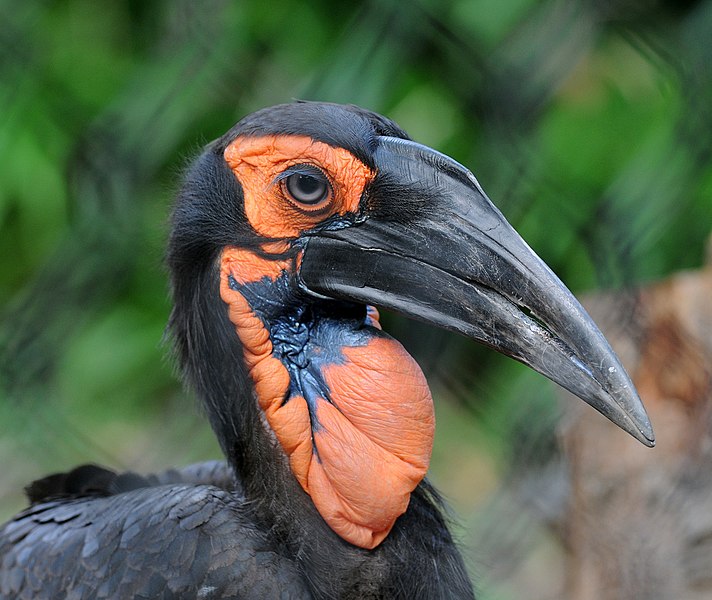Southern Ground-Hornbill Bird Details
Bucorvus leadbeateri
Southern Ground-Hornbill
NA
Nicholas Aylward Vigors, 1825
Bucerotiformes (HOOPOES and HORNBILLS)
Bucorvidae
Bucorvus
Angola, Botswana, Kenya, Mozambique, Namibia, South Africa, Swaziland, Tanzania, Zambia, and Zimbabwe.
Appearance :
Southern Ground-Hornbills are large birds with black feathers and striking red facial skin and throat pouches. They have long, sturdy bills and bare patches of skin around their eyes.
Behaviour :
They are known for their terrestrial habits, often seen walking on the ground in search of food. They are also social birds, living in groups called clans.
Habitat :
They inhabit savannas, woodlands, and grasslands with some tree cover across sub-Saharan Africa.
Diet :
Their diet consists mainly of small vertebrates like frogs, reptiles, small mammals, and birds. They also consume insects and occasionally fruits.
Conservation Status :
Vulnerable
Distribution :
They are found in various countries across sub-Saharan Africa, primarily in countries like South Africa, Zimbabwe, Botswana, Kenya, and Tanzania.
Population Size :
Fewer than 5,000 mature individuals.
Life Span :
Live up to 50-60 years.
Body And Tarsus:
Large, predominantly black with white primary feathers. Tarsus relatively long compared to body size, aiding in its ground-dwelling habits.
Head And Bill :
Large head with a prominent downward-curved bill, colored black with some red patches.
Length :
90 to 130 cm (35 to 51 inches) in length.
Neck :
Long neck, characteristic of ground-hornbills.
Size :
One of the largest hornbill species.
Tail Details :
Short tail relative to body size. Approximately 37 to 50 cm (15 to 20 inches).
Weight :
Between 3 to 6 kg (6.6 to 13.2 lbs).
Wing :
Broad wings adapted for powerful flight.
Wing Span :
180 to 200 cm (71 to 79 inches).
Facial Feature :
Distinctive facial skin patches with vivid colors (red, blue) which become brighter during courtship displays.
Nest Details :
- Nest: Large cavity in a tree or rock crevice.
- Nest Made Up Of: Lined with leaves and grass.
Breeding Season :
Typically during the rainy season.
Nesting Season :
Often during the dry season in savannas or woodlands.
Egg Color :
White or pale blue.
Egg Length :
Around 90 mm (3.5 inches).
Egg Width and Weight :
Approximately 60 mm (2.4 inches). Each egg weighs about 164 grams (5.8 ounces).
Clutch Size :
Usually 1 to 2 eggs.
No. of Broods :
Generally one brood per breeding season.
Incubation Period :
Roughly 37 to 41 days, usually shared between both parents.
Nestling Period :
Fledge at about 85 to 95 days after hatching.
Vocalization :
Loud, booming calls that carry long distances; used for territorial defense and communication within the group.
Sex Demorphism :
Slight differences in size and coloration between males and females; males tend to be larger with brighter facial patches.
Migration Details :
They are mostly sedentary. Non-migratory Birds.
Explore More Birds Of Same Genus





